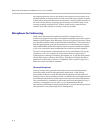
Design Guide for the Polycom SoundStructure C16, C12, C8, and SR12
B - 8
Wireless Microphones
Wireless microphones are also commonly used in conferencing applications,
particularly for presenters. The advantage of wireless microphones is that
they may be used anywhere within the room (depending on whether in-room
sound reinforcement is used with that microphone) and have the advantage
that they are usually closer to the local talker's mouth than a tabletop
microphone. It is better to use a lavalier style of wireless microphone than a
hand-held wireless microphone to ensure that the microphone stays a constant
distance from the talker's mouth which will minimize the sound level
variation to the remote participants in a conferencing application. Wireless
handheld microphones typically end up being placed on tables, used as
pointing devices, and end up in other situations that reduce the quality of the
resulting audio signal. One consideration with lavalier microphones is to
ensure the users of the microphones understand where to attach the
microphone to minimize the occurrence of fabric being dragged across the
microphone element.
There are different methods of transmission that wireless microphones use,
ranging from analog transmission over UHF or VHF frequencies to digital
encrypted transmissions over a 2 GHz frequency band. Considerations for
choosing a wireless microphone include the signal bandwidth that is
transmitted (narrow or wide band), the latency introduced by the wireless
microphone, the battery type and life (rechargeable or not), reliable
transmission distances, cost, freedom from interference, and whether it uses
encryption to secure the wireless channel.
Ceiling Microphones - Quality vs Convenience
In all applications, getting the microphone closer to the local talker results in a
higher quality signal due to improved signal-to-noise ratio (the local talker is
louder compared to the background noise) and a reduction in the amount of
the multipath signal compared to the original signal.
In most conferencing applications there is a trade-off with the usage of a room,
the location and configuration of the furniture, and the maximum achievable
audio quality. It is common for rooms with movable furniture to not have
permanently installed microphones on the tables. To accommodate this,
microphones are often moved away from the participants and placed in the
ceiling. A consequence of this is that the resulting signal picked up by the
microphone includes significant amount of additional noise sources that are
closer to the microphone than the talker such as HVAC. In addition, the local
talker's mouth will be farther from the microphone, reducing the signal level
that is picked up by the microphone. Any additional gain added to pick up
the local talker's signal will also amplify the background noise, exacerbating
the problem.
To set proper expectations, demonstrate the audio quality of a ceiling
microphone in the target room as early in the design process as possible. This
can be done simply by temporarily hanging a microphone from a ceiling with
tape or some other temporary adhesive, and running the microphone cable to
a location acoustically isolated from where the microphone is temporarily


















